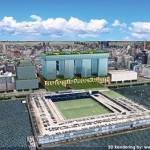Bulk
Bulk regulations are the combination of controls (lot size, floor area ratio, lot coverage, open space, yards, height and setback) that determine the maximum size and placement of a building on a zoning lot.
Contextual Zoning
Contextual zoning regulates the height and bulk of new buildings, their setback from the street line, and their width along the street frontage, to produce buildings that are consistent with existing neighborhood character. Residential and commercial districts with an A, B, D or X suffix are contextual zoning districts.
| A transfer of development rights (TDR) allows for the transfer of unused development rights from one zoning lot to another in limited circumstances, usually to promote the preservation of historic buildings, open space or unique cultural resources. For such purposes, a TDR may be permitted where the transfer could not be accomplished through a zoning lot merger. In the case of a landmark building, for example, a transfer may be made by CPC special permit from the zoning lot containing the designated landmark to an adjacent zoning lot or one that is directly across a street or, for a corner lot, another corner lot on the same intersection. | |
| Floor Area Ratio (FAR)
The floor area ratio is the principal bulk regulation controlling the size of buildings. FAR is the ratio of total building floor area to the area of its zoning lot. Each zoning district has an FAR which, when multiplied by the lot area of the zoning lot, produces the maximum amount of floor area allowable on that zoning lot. For example, on a 10,000 square foot zoning lot in a district with a maximum FAR of 1.0, the floor area on the zoning lot cannot exceed 10,000 square feet. |
|



